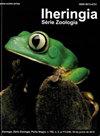贝尔顿四十年后:对巴西南里奥格兰德州鸟类的记录和证据的回顾
IF 0.5
4区 生物学
Q4 ZOOLOGY
引用次数: 13
摘要
基于对2011年2月至2017年7月积累的新记录和证据的全面审查,我们提出了巴西南里约热内卢格兰德州鸟类名单的最新更新。这是自1978年威廉·贝尔顿(William Belton)出版第一本基于该州相当完整的地理覆盖的汇编以来的第五次更新,也是由一个地区(非正式)委员会编写的第二次更新。它也是第一个广泛使用互联网上共享门户网站和数字数据库上提供的公民科学贡献的项目。新增43个分类群,最终名录共有704种,比2010年第一次评估增加6.5%。2种因分类学变化而被替换。此处指出或发布了基于未发表记录的包含文档。我们还更新了先前列入名单的另外20个物种的文献。包含物主要代表该州记录的移民,如流浪者或不定期访客(22),但也包括最近范围扩大(特别是来自北方)和以前被忽视的居民或迁徙分类群。平均增加率(每年超过6种)比前一时期高30%,预计还会加快。该州未记录在案的可接受物种的比例从2010年的1.8%下降到目前的0.7%。我们将这些结果归因于近年来该州更好的时空覆盖,主要是由于业余爱好者的贡献越来越大,他们占新事件的60%。相比之下,博物馆标本记录的物种百分比随着时间的推移稳步下降(目前为84%)。由于博物馆标本的重要性和实用性,国家在科学研究和收集凭证标本方面的投资应该跟上社会对鸟类日益增长的兴趣。本文章由计算机程序翻译,如有差异,请以英文原文为准。
Four decades after Belton: a review of records and evidences on the avifauna of Rio Grande do Sul, Brazil
We present a new update of the list of birds of the state of Rio Grande do Sul, Brazil, based on a thorough review of new records and evidences accumulated from February 2011 to July 2017. This is the fifth update since the first compilation based on a reasonably complete geographic coverage of the state, published by William Belton in 1978, and the second produced by a regional (informal) committee. It is also the first to widely use citizen science contributions available on shared portals and digital databases on the internet. 43 taxa were added, resulting in a final list with 704 species, 6.5% more than in the previous assessment in 2010. Two species were replaced due to taxonomic changes. Documentation for inclusions based on unpublished records is indicated or published here. We also updated the documentation of another 20 species previously included in the list. Inclusions represent mainly migrants recorded in the state as vagrants or irregular visitors (22), but also cases of recent range expansion (especially from the north) and previously overlooked resident or migratory taxa. The average rate of additions (over six species per year) was 30% higher than in the previous period and is expected to accelerate. The percentage of accepted species without documented records in the state decreased from 1.8% in 2010 to 0.7% in the current list. We attribute these results to a better spatial and temporal coverage of the state in recent years, mainly due to the increasing contribution of amateurs, who accounted for 60% of the new occurrences. In contrast, the percentage of species documented by museum specimens has decreased steadily over time (currently at 84%). Investment in scientific research and collection of voucher specimens in the state should keep pace with the growing interest birds arouse in society, due to the importance and usefulness of museum specimens.
求助全文
通过发布文献求助,成功后即可免费获取论文全文。
去求助
来源期刊

Iheringia Serie Zoologia
生物-动物学
CiteScore
1.00
自引率
0.00%
发文量
12
审稿时长
6-12 weeks
期刊介绍:
The journal Iheringia, Série Zoologia, edited by the “Museu de Ciências Naturais” of the “Fundação Zoobotânica do Rio Grande do Sul”, publishes original research findings in zoology with emphasis on taxonomy, systematics, morphology, natural history, and community or population ecology of species from current Neotropical fauna. Scientific notes will not be accepted for publication. Species lists without a taxonomic approach, or that are not the result of studies on the ecology or natural history of communities will not normally be accepted. The same applies to identification keys of groups of taxa defined by political boundaries. Authors wishing to inquire about the scope of the journal or the suitability of a particular topic are encouraged to contact the Editorial Board prior to submission. Furthermore, articles with a main focus on agronomy, veterinary, zootechny or other areas involving applied zoology will not be accepted.
Its abbreviated title is Iheringia, Sér. Zool., which should be used in bibliographies, footnotes and bibliographical references and strips.
 求助内容:
求助内容: 应助结果提醒方式:
应助结果提醒方式:


